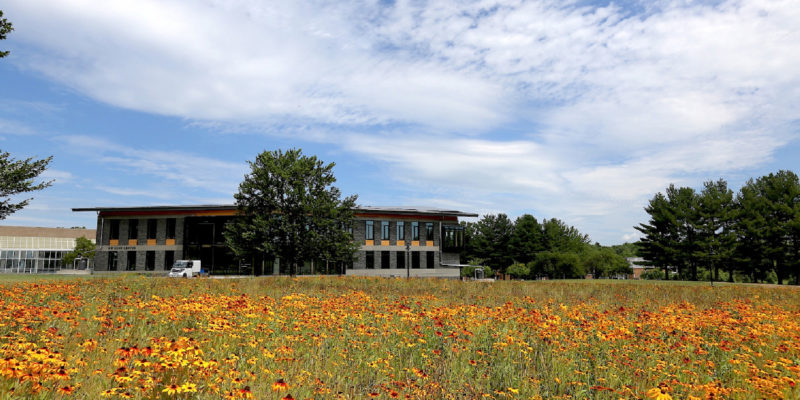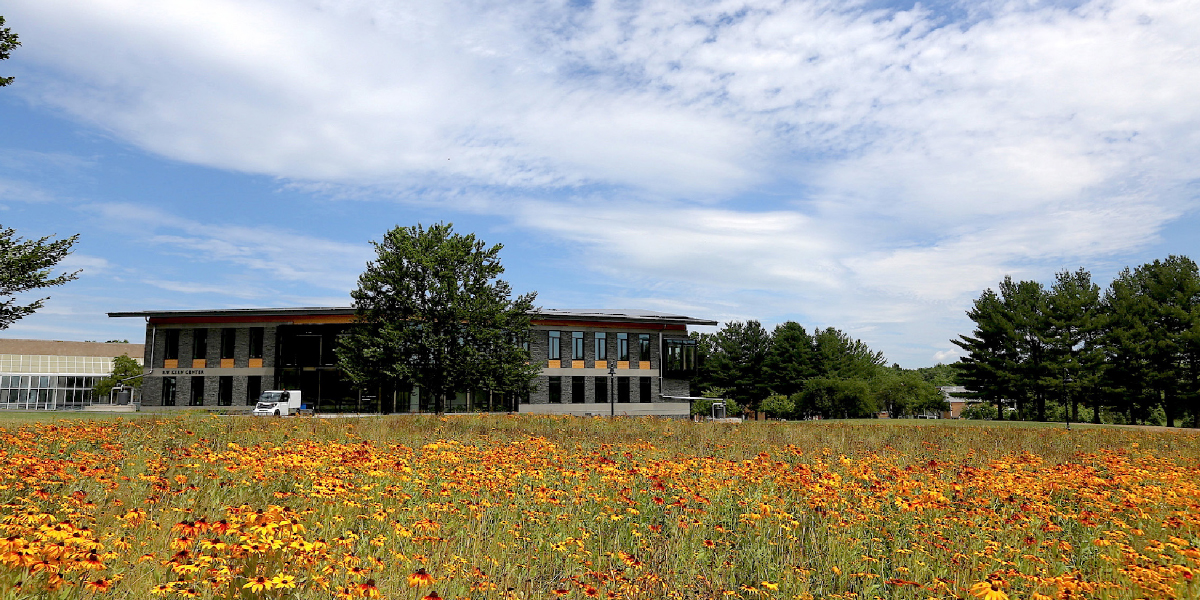Four years after a committee of faculty, staff, and students began planning Hampshire College’s first new building in more than 25 years, the R.W. Kern Center opened its doors last June. The facility is the new home of the admissions and financial aid offices, state-of-the-art classrooms, a large atrium, and a small café. This welcoming space embodies Amherst, Mass.–based Hampshire College’s values, and emphasizes its commitment to teaching, learning, and reducing environmental impact through better use of energy and land.
Made possible by a leading gift from alumnus Bill Kern, and his mother, Leona, the $9.3 million project is built to one of the most advanced green-building standards—the Living Building Challenge (LBC). This building certification program, introduced in 2006 by the International Living Future Institute, comprises seven performance categories: place, water, energy, health and happiness, materials, equity, and beauty.
The LBC aims to break society’s dependence on environmentally harmful practices, to protect not only the environment, but also those who make the materials and install them, and those who use the building. One of its goals is to compel improvements in the building and construction sector. The Kern Center, for example, makes its own energy; collects, treats, and distributes its own greywater; and was built from materials—mainly from local sources—containing no chemicals dangerous to those who produce, use, or are exposed to them.
The first hint of something different appears as soon as you see the new building, prominent yet nestled among wildflowers. It features a large roof covered in solar panels, windows that soar from floor to ceiling, and exterior window shades controlled electronically by the intensity of the sun. Two cisterns capture rainwater runoff from the roof to supply the building’s water needs. Inside, the atrium is ringed with indigenous plants that both oxygenate the space and process greywater. Air-sourced heat pumps provide either heating or air conditioning, depending on the season.
Finding Alternatives
The contractor, Wright Builders, and the architectural firm of Bruner/Cott & Associates worked with our internal project coordinator to vet the building materials and processes used. This team needed to find a local source for every material; verify that every material was nontoxic, sustainable, and replenishable; and maintain supporting documentation for certification. As an example, the Kern Center does not contain any polyurethane coating, which appears on the list of products that cannot be used in a Living Building. Instead, the all-wood structure was treated with a byproduct of the cheese-manufacturing process that serves as a preservative.
The project team contacted numerous manufacturers during the design phase, often communicating directly with product chemists to document and verify ingredients. More than 800 of the project’s building materials were scrutinized in this way—six times the average for a construction project of the same size. Consequently, a building that might typically be constructed in one year, may take up to two years. In addition, the cost of constructing a Living Building is 10 to 20 percent higher, but we project those additional costs will be recouped through many years of utility savings.
As time consuming as the building process was, the Kern Center is one of the healthiest buildings possible for people to work in and visit. It has quickly become a point of pride on campus for its focus on sustainability and stewardship, demonstrated by the following:
- Estimated daily water usage totals less than 100 gallons a day, thanks in large part to composting toilets that do not require flushing. In comparison, a similarly sized building would normally use 1,000 gallons per day.
- Insulated for high-energy efficiency, the Kern Center has R-40 walls and an R-60 roof, which have high levels of insulation.
- The 345 rooftop solar panels generate electricity under a net metering agreement with Eversource, our local provider. Every computer, light, and appliance powered by electricity was vetted for efficiency, to ensure that the building can produce 100 percent of its own electric needs.
- In the basement, a complex but miniature treatment plant filters and cleans the water for consumption by building occupants. We also have a leach field as a backup system. Serving as our own water source has required certification from the Massachusetts Department of Environmental Protection to meet the same water quality regulations as any municipality in the state.

The Kern Center features 10 “puzzles” related to the Living Building categories. These word or math puzzles, designed by a faculty member who teaches classes on gaming, are intended to spark interest and further exploration in the area of sustainability. The building itself has been integrated into curricula in a range of disciplines, including technology, environmental studies, the sciences, and math. Natural science students, for example, are watching the plants in the atrium and charting the microbial actions that occur through the application of recycled greywater. And recently, at the American Ecological Engineering Society’s annual meeting, a team of Hampshire College undergraduates won the first prize in an ecological-design challenge, based in large part on their knowledge of the Kern Center’s water systems.
High Standards
To date, fewer than one dozen buildings in the world have earned Living Building certification. To be eligible to join that select group, the Kern Center must meet a series of performance requirements during its first 12 months of continuous occupancy. While we are documenting those results, another Living Building is under construction on campus in a cooperative arrangement with the Hitchcock Center for the Environment. Hampshire aims to be the first college in the world with two living buildings on its campus.
Numerous other initiatives are underway to meet Hampshire’s ambitious goal of making campus operations carbon neutral by 2020. For several years, for example, 15 of the college’s 800 acres have been under cultivation; the Hampshire Farm Center produces some of the food served in our dining commons. Last year, the college eliminated a long-standing oval driveway from the middle of the main quad, returning it to the original wildflower meadow to bring nature and pedestrians back to the center of campus. Hampshire also stopped mowing 10 acres of lawn to further reduce carbon dioxide emissions. We are currently working with Eversource to install two large solar fields that, on an annualized basis, will provide 100 percent of the electricity used by the core campus.
In keeping with our educational mission, Hampshire recently hosted a symposium for contractors and other parties interested in sustainable architecture and construction. The daylong event included a dedication ceremony for the Kern Center and lunch provided by the Hampshire farm—fully compostable and recyclable, of course.
SUBMITTED BY Mary McEneany, vice president for finance and administration and treasurer, Hampshire College, Amherst, Mass.



